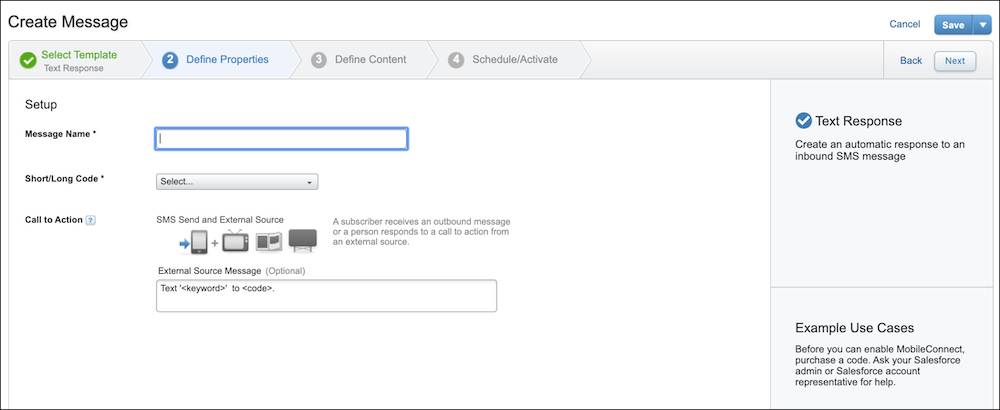Send SMS Messages
Learning Objectives
After completing this unit, you’ll be able to:
- Navigate MobileConnect.
- Create keywords in MobileConnect.
- Import contacts into MobileConnect.
- Create an SMS message.
- Identify SMS campaign types.
Get to Know MobileConnect
With MobileConnect, you can easily create SMS campaigns using prebuilt templates and then personalize those messages using your customer data. Before we dive into all the cool stuff you can do, let’s review the MobileConnect pages to get familiar with the interface.
First up, the Overview tab. Here you can create messages, reports, and manage mobile contacts.

Next, you’ll find the Administration tab, where you can adjust settings, update From Names, and schedule a blockout window. You can also drill down further into each provisioned code from this tab to see specific account settings and keywords. Let’s review a few of these settings in more detail.
(1) Headers and Footers
Create a header and footer to quickly add consistency to all future text messages. It also helps for brand recognition if you aren’t able to use From Names in your market.
(2) Send Blockout
A send blockout is a period during which messages can’t be scheduled from your MobileConnect account. This feature helps keep your subscribers happy. (No one wants to be woken up by a text at 4 AM) Be sure to set this up or you could face responses from customers like: STOP, Leave me alone, I’m trying to sleep, and so on.
Choose a Memorable Keyword
Now that you’ve taken a look around MobileConnect, let’s set up the all-important keywords. MobileConnect has a few noneditable keywords that you need to have active in your account. HELP for recipients to request assistance and STOP so they can unsubscribe (Alternatives to STOP include: QUIT, CANCEL, END, and UNSUBSCRIBE. These are considered global STOP keywords). Beyond that, you are free to use any keywords you would like. Keep in mind that good keywords:
- Are unique and only used once
- Aren’t case sensitive
- Are memorable and easy to type
- Account for autocorrect failures or common typing errors (Burgur, bergur… I meant BURGER!)
Overall keywords should be short, related to your brand, and unique to a campaign.
Step-by-Step Instructions
In this module, we assume you are a Marketing Cloud Engagement user. If you’re not, that’s OK. Read along to learn how you would take the steps in a production org. Don't try to follow these steps in your Trailhead Playground. Marketing Cloud Engagement isn't available in the Trailhead Playground.
Create a New Keyword
Remember Scott’s Restaurant and Bar? Simone Wright, Scott’s digital marketer, needs to set up a few keys words in Marketing Cloud Engagement to start promoting her SMS program to customers. Let’s follow along as she creates that important keyword, BURGER. First, Simone navigates to MobileConnect. Then under the Administration tab, she selects the customer short code (sample code 12345). Then she simply clicks Create Keyword and enters in BURGER and then clicks Save. Now when a customer texts BURGER to 12345, they are added to that particular campaign. Pretty simple, right? Let’s talk more about getting customers to join your program.
Add Contacts
Your SMS codes are up and running. Your keywords are ready to go. What next? Subscribers. As we mentioned, customers are added to your contacts as soon as they opt-in to your messages using a keyword, like BURGER. But how do they know the keyword and your code? That’s where your marketing expertise comes in handy. And it’s okay to start small. Here’s some simple in-store signage that Scott’s Restaurant and Bar uses to promote their SMS program.

SMS Promotion Ideas
- In-store signage
- Content block in your existing emails promoting SMS
- SMS email campaign with incentive to sign-up for mobile
- Facebook ad
- Content on your website
- Article in newsletter with SMS benefits
- Promotion in monthly snail-mail statements
Just remember to clearly highlight the benefits of your SMS program and be sure to have your program in place and ready to go before advertising.
Existing Subscribers
What about your current subscribers? No problem. Subscribers can be added into Marketing Cloud Engagement manually or through an import, as long as the customer has previously opted into mobile messages. You can also add contacts to MobileConnect via API.
Two things to remember:
- A subscriber who consents to receive email is not the same thing as a subscriber who consents to mobile.
- Before adding new contacts, make sure to confirm the user isn’t already added—no one wants duplicate contacts.
Got it? Good. Let’s review how you can add contacts using data extensions (with some requirements).
Import contacts
You can either add the required fields to an existing data extension or create a separate data extension for SMS subscribers. In order to send messages from a data extension, the data extension must follow these requirements:
- Mobile Number: Mobile numbers should be normalized with country code + phone number with no dashes or parentheses.
- Country Code/Locale: Include the five-character country code or locale. (Find Valid Locales for Data Extension Sends.)
- Subscriber/Contact Key: To send SMS messages using a data extension or in Journey Builder, you need to include subscriber key (if using it with Marketing Cloud Engagement email) or contact key from Contact Builder.
- Marked as sendable: When creating a new data extension, be sure Is Sendable is checked.
You can also include first name, last name, and any other fields you need for personalization purposes. Once your file is ready, head to MobileConnect or Contact Builder to import your mobile contacts.
Create SMS Messages
Now for the fun stuff—let’s create a message. Let’s follow along as Simone configures the auto response for Scott’s Restaurant and Bar customers who want to opt-in to their campaigns. She starts on the overview page of MobileConnect and clicks Create Message. She selects the Text Response template and then Next.

Simone adds a message name and selects the customer code and then the keyword. For her reference, she can include the message her customers see that prompts a response (also known as the External Source Message). This might be the signage they see in the restaurant with the message: Text BURGER to 12345. Once done, she clicks Next. She then enters the auto response message: “Thank you for signing up for Scott’s customer loyalty program. Please confirm by responding with a Y or Yes.” Now she’s ready to welcome new SMS customers.
Craft Your Message
Let’s take a moment to talk about the actual message. In addition to crafting a text response, there are several other campaign possibilities to consider. Here are some campaigns and examples.
| Campaign Type |
When to Use |
Examples/Benefits |
|---|---|---|
|
Text Response |
Send an automatic response to incoming SMS messages with a specific keyword. |
|
|
Transactional
|
Deliver time-sensitive messages that provide immediate value to your customers. |
|
|
Broadcast |
Send targeted offers or information to valued customers. |
|
|
Vote/Survey |
Invite people to vote or respond to a survey via SMS. |
|
|
Progressive Profile
|
Engage users in two-way automations to gather feedback and provide customer service. |
|
|
Media Response |
Create an automatic MMS response to an inbound SMS message. |
|
Simone has already created her text response message, so she then clicks through the schedule/activate tab to confirm her scheduling options. What are those scheduling options? Coming right up.
Review Your Send Options
You want your well-crafted messages to arrive at just the right time. So it’s great to have options for when and how to send. Let’s review.
| Type |
Description |
Considerations |
|---|---|---|
|
Schedule
|
Send message either immediately or at a specified time in the future. |
Similar to email, we recommend testing send time based on your message and the desired outcome. If you desire a response, test to see if subscribers respond better during business hours or in the evening. |
|
API Trigger |
Send message in real time via REST API. |
Review the developer documentation: MobileConnect REST API. |
|
Automation |
Send message as part of an automation in Automation Studio. |
Learn how to use MobileConnect in Automation Studio. |
In summary, the always on and always near nature of mobile devices makes it a channel in which customers have a low tolerance for annoyance. So when communicating in such a personal format, send a valuable, concise message with a clear call to action. In the next unit, we cover SMS analytics and deliverability. BCNU (be seeing you).
